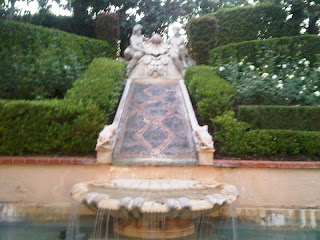Your stomach is growling with hunger pains and you need
a great place to eat. You don’t want just any place but need that perfect place
that expresses your mood. Feeling a little upscale with that great bonus you
just received from work you scan your memory for a restaurant that will not
only satisfy your appetite but also perpetuate that positive feeling into the
evening. You know big things are going
to happen since you have now been recognized for your great work. Thinking of
possible alternatives you finally settle on a fancy French establishment with
valet, fireplaces, patio dining, fountains and violin music in the background.
It costs more but heck it still feels great to spend your reward for superior
effort!
What you have just thought about is called
servicescape. The servicescape is the physical environment that customers exist
in that influences both customer behavior as well as overall impression of the
business. Successful retail management includes the understanding of physical
layout and how this impacts the overall customer experience and impressions of
the total experience.
Such experience is often seen in the way
establishments are designed, how atmosphere feels, and the overall impression
that customers leave with. Knowing and managing the servicescape can help
create positive feelings and memories that help to cater to customer’s self
impression. Servicescapes often include the following concepts (Fitzsimmons
& Fitzsimmons, 2011).
- 1.) Ambient conditions: The back ground of the environment such as lighting, temperature, noise music, etc… This is the general use of our five senses to create a culture and environment that encourages positive feelings and memories of an organization. Nothing sells a home like the sweet smell of Apple Pie.
- 2.) Spatial Layout and Functionality: The successful layout of an environment often determines how well customers can manage to find their way within the environment in order to encourage quick paced purchasing behavior. When the layout of the establishment is not strong a resulting safety and service problem results.
- 3.) Signs, Symbols and Artifacts: The signs, symbols and artifacts create a perception of the business as it relates to its value and purpose. Those signs, symbols and artifacts can also create impressions of an organization. For example, a high end restaurant is likely to have fireplaces, pictures of elaborate dinners, and certain types of silverware to ensure that all of these factors are in alignment with the sales product.
One of the beneficial ways to encourage stronger
servicescapes that lead to stronger sales and customer satisfaction is through
the use of surveys. Surveying customers helps organizations understand the
overall perception of the environment, layout, and symbolism of the
organization. For example, A total of 109 participants from six hotels in Delhi
india found a positive relationship between ambience, spatial relationship, and
symbolism on customer support (Medabesh & Upadhyaya, 2012). This study
helps highlight the overall nature of the need servicscapes in enhancing
products and services.
With servicescapes the devil is often in the
details. The right forks, flowers, table cloth, temperature, food design, food
offerings, decorations, etc… all work together. Understanding how these
multiple aspects of the business fit together to create a totality of
impression can do wonders with enhancing the sensory experience of customers.
The next time you go to eat remember that it isn’t only the food that counts.
Fitzsimmons, J. & Fitzsimmons, M. (2011). Service
Management: Operations, Strategy, Information Technology (Seventh Edition).
NY: McGraw-Hill.
Medabesh, A. & Upadhyaya, M. (2012).
Servicescape and customer substantiation of star hotels in India’s metropolitan
city of Delhi. Journal of Marketing &
Communication, 8 (2).

No comments:
Post a Comment